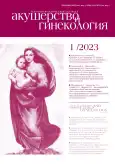Correction of iron deficiency states in reproductive-aged patients with chronic abnormal uterine bleeding
- Authors: Savelyeva I.V.1, Nosova N.V.1, Bukharova E.A.1, Prodanchuk E.G.1, Galyanskaya E.G.1
-
Affiliations:
- Omsk State Medical University Ministry of Health of Russia
- Issue: No 1 (2023)
- Pages: 93-99
- Section: Articles
- Published: 15.01.2023
- URL: https://journals.eco-vector.com/0300-9092/article/view/250119
- DOI: https://doi.org/10.18565/aig.2023.12
- ID: 250119
Cite item
Abstract
Full Text
About the authors
Irina V. Savelyeva
Omsk State Medical University Ministry of Health of Russia
Email: saveljeva_iv_omsk@mail.ru
Dr. Med. Sci., Professor, Head of the Department of Obstetrics and Gynecology No. 1
Natalya V. Nosova
Omsk State Medical University Ministry of Health of Russia
Email: natalya-nosova-85@mail.ru
Assistant Professor, Department of Obstetrics and Gynecology No. 1
Elena A. Bukharova
Omsk State Medical University Ministry of Health of Russia
Email: buxarova88@mail.ru
Assistant Professor, Department of Obstetrics and Gynecology No. 1
Eugene G. Prodanchuk
Omsk State Medical University Ministry of Health of Russia
Email: ompeg@mail.ru
PhD, Associate Professor, Department of Obstetrics and Gynecology No. 1
Elena G. Galyanskaya
Omsk State Medical University Ministry of Health of Russia
Email: galyanskaya@mail.ru
PhD, Associate Professor, Department of Obstetrics and Gynecology No. l
References
- Соловьева А.В., Чегус Л.А. Аномальные маточные кровотечения у женщин в репродуктивном возрасте и пременопаузе. Акушерство и гинекология. 2020; 8: 29-38. https://dx.doi.Org/10.18565/aig.2020.8.29-38.
- Министерство здравоохранения Российской Федерации. Клинические рекомендации. Аномальные маточные кровотечения. М.; 2021.
- Munro M.G., Critchley H.O., Broder M.S., Fraser I.S.; FIGO Working Group on Menstrual Disorders. FIGO classification system (PALM-COEIN) for causes of abnormal uterine bleeding in nongravid women of reproductive age. Int. J. Gynaecol. Obstet. 2011; 113(1): 3-13. https://dx.doi.org/10.1016/j.ijgo.2010.11.011.
- Munro M.G., Critchley H.O.D., Fraser I.S.; FIGO Menstrual Disorders Committee. The two FIGO systems for normal and abnormal uterine bleeding symptoms and classification of causes of abnormal uterine bleeding in the reproductive years: 2018 revisions. Int. J. Gynaecol. Obstet. 2018; 143(3): 393408. https://dx.doi.org/10.1002/ijgo.12666.
- Кузнецова И.В., Беришвили М.В. Латентный дефицит железа и железодефицитная анемия у женщин с обильными менструациями. Женская клиника. 2022; 3: 29-37.
- Camaschella C. Iron deficiency. Blood. 2019; 133(1): 30-9. https://dx.doi.org/10.1182/blood-2018-05-815944.
- Friedman A.J., Chen Z., Ford P., Johnson C.A., Lopez A.M., Shander A. et al. Iron deficiency anemia in women across the life span. J. Womens Health (Larchmt). 2012; 21(12): 1282-9. https://dx.doi.org/10.1089/jwh.2012.3713.
- Milman N., Taylor C.L., Merkel J., Brannon P.M. Iron status in pregnant women and women of reproductive age in Europe. Am. J. Clin. Nutr. 2017; 106(Suppl. 6): 1655S-662S. https://dx.doi.org/10.3945/ajcn.117.156000.
- Suchdev P.S., Williams A.M., Mei Z., Flores-Ayala R., Pasricha S.R., Rogers L.M., Namaste S.M. Assessment of iron status in settings of inflammation: challenges and potential approaches. Am. J. Clin. Nutr. 2017; 106(Suppl. 6): 1626S-33S. https://dx.doi.org/10.3945/ajcn.117.155937.
- Coad J., Pedley K. Iron deficiency and iron deficiency anemia in women. Scand. J. Clin. Lab. Invest. 2014; 244(Suppl.): 82-9. https://dx.doi.org/10.3109/00365513.2014.936694.
- Townsley D.M. Hematological complications of pregnancy. Semin. Hematol. 2013; 50(3): 222-31. https://dx.doi.org/10.1053/j.seminhematol.2013.06.004.
- Burdge G.C., Lillycrop K.A. Folic acid supplementation in pregnancy: Are there devils in the detail? Br. J. Nutr. 2012; 108(11): 1924-30. https://dx.doi.org/10.1017/S0007114512003765.
- WHO Guidelines Approved by the Guidelines Review Committee. Guideline: daily iron and folic acid supplementation in pregnant women. Geneva: World Health Organization; 2012.
Supplementary files






